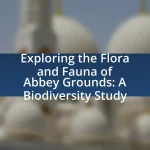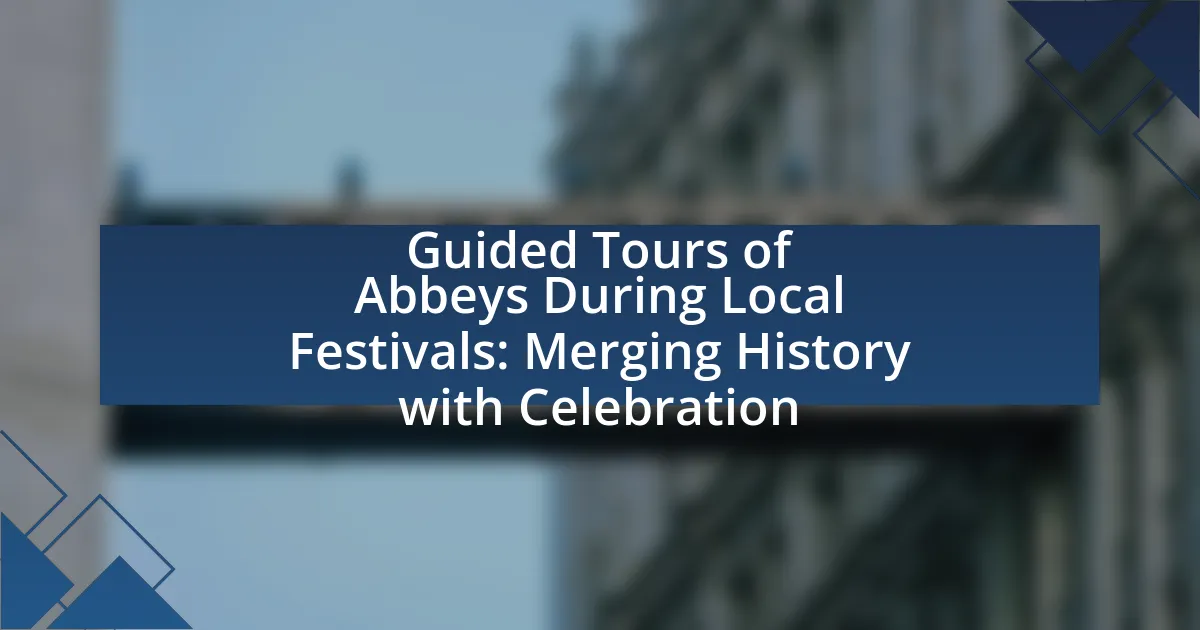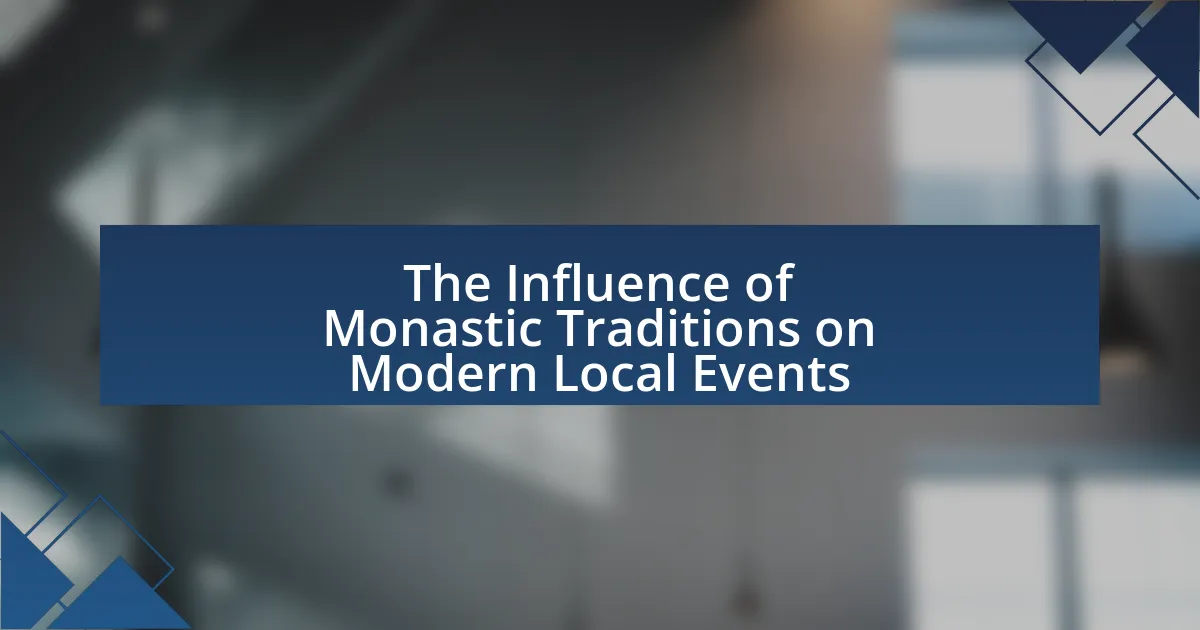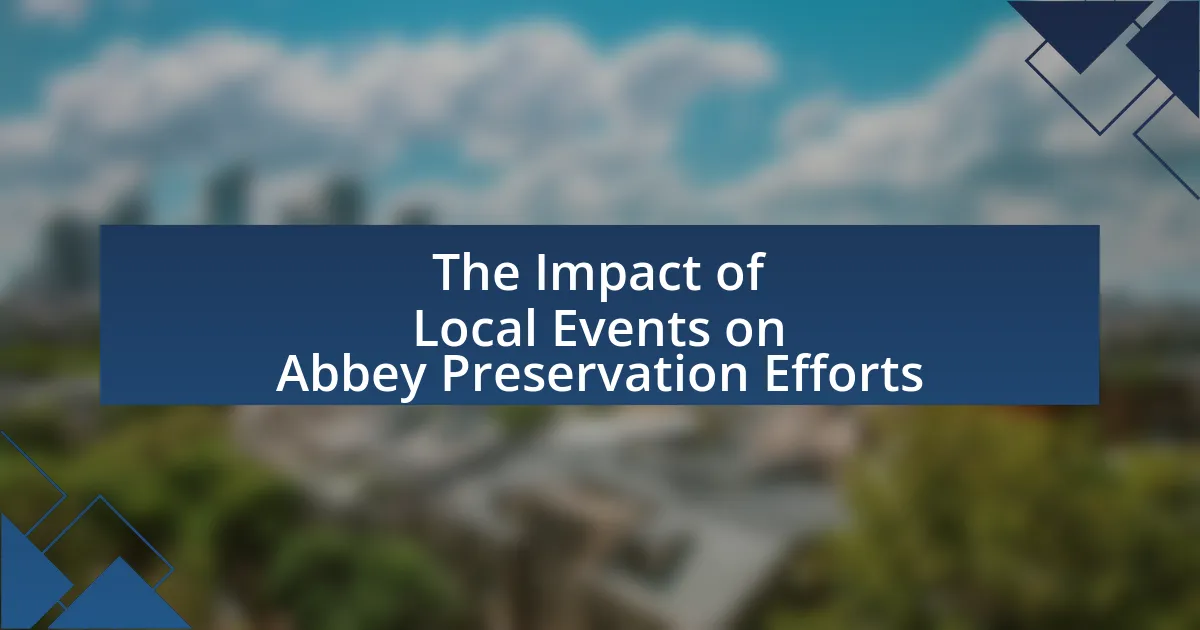Seasonal festivals at abbeys are celebrations that reflect the changing seasons, deeply rooted in historical and religious traditions. These festivals encompass activities such as feasting, music, and communal gatherings, often aligned with the agricultural calendar and significant Christian observances. The article explores the evolution of these festivals from ancient agricultural rituals to modern celebrations, highlighting their cultural significance and the influence of local customs. It also examines the role of seasonal festivals in monastic life, their impact on community bonding, and the various types of festivals celebrated, including Harvest Festivals, Advent, and Easter. Additionally, the article discusses how abbeys adapt their celebrations to reflect regional traditions and how visitors can engage with these vibrant cultural events.
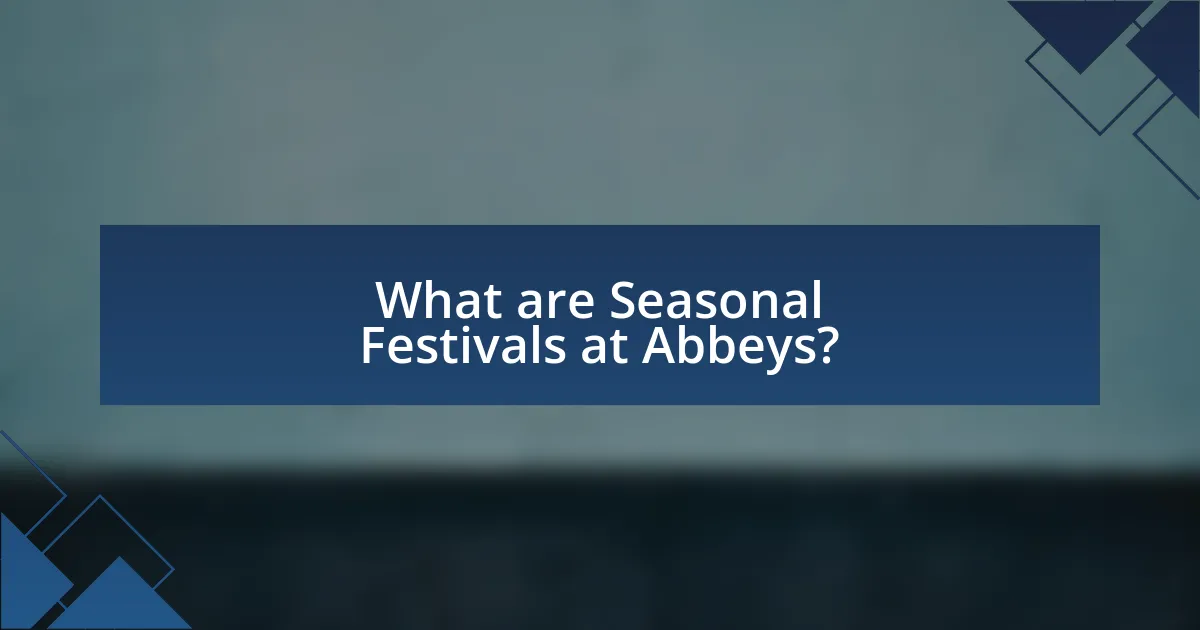
What are Seasonal Festivals at Abbeys?
Seasonal festivals at abbeys are celebrations that mark the changing seasons, often rooted in historical and religious traditions. These festivals typically include activities such as feasting, music, and communal gatherings, reflecting the agricultural calendar and the spiritual significance of each season. For example, many abbeys celebrate harvest festivals in the fall to give thanks for the crops, while spring festivals may focus on renewal and rebirth, aligning with Christian observances like Easter. Historical records indicate that these festivals have been integral to monastic life, fostering community bonds and preserving cultural heritage.
How have Seasonal Festivals evolved throughout history?
Seasonal festivals have evolved from ancient agricultural rituals to modern celebrations that reflect cultural diversity and community values. Initially, these festivals were closely tied to the agricultural calendar, marking planting and harvest times, as seen in ancient civilizations like Mesopotamia and Egypt, where festivals honored deities associated with fertility and harvest. Over time, with the spread of Christianity, many pagan festivals were adapted into Christian celebrations, such as the transformation of the pagan midwinter festival into Christmas. In contemporary society, seasonal festivals have diversified, incorporating various cultural traditions and emphasizing themes like sustainability and community engagement, as evidenced by events like Earth Day and local harvest festivals. This evolution illustrates how seasonal festivals have maintained their core purpose of celebrating the changing seasons while adapting to societal changes and cultural exchanges.
What historical events influenced the development of these festivals?
The development of seasonal festivals at abbeys was significantly influenced by the agricultural calendar and religious observances. The agricultural calendar dictated the timing of harvests and planting, leading to festivals that celebrated these cycles, such as harvest festivals in the fall. Additionally, the Christian liturgical calendar incorporated pagan traditions, transforming them into religious celebrations, like Easter and Christmas, which aligned with pre-existing seasonal festivities. Historical events, such as the spread of Christianity in Europe during the Middle Ages, further shaped these festivals by integrating local customs into church practices, thereby solidifying their importance in community life.
How did different cultures contribute to the celebration of seasons at abbeys?
Different cultures contributed to the celebration of seasons at abbeys by integrating their unique traditions, rituals, and agricultural practices into the monastic calendar. For instance, Celtic traditions influenced the celebration of the harvest season with festivals like Lammas, which marked the first fruits of the harvest, while Roman customs introduced the concept of seasonal feasts such as Saturnalia, which celebrated the winter solstice. Additionally, the incorporation of local agricultural cycles, such as planting and harvest times, allowed abbeys to align their liturgical celebrations with the rhythms of nature, fostering a sense of community and continuity. Historical records indicate that these cultural exchanges enriched the spiritual life of abbeys, making seasonal celebrations more vibrant and reflective of the diverse populations surrounding them.
Why are Seasonal Festivals significant in monastic life?
Seasonal festivals are significant in monastic life because they serve as vital communal events that reinforce spiritual practices and foster a sense of unity among the monastic community. These festivals mark the changing seasons, aligning the monastic calendar with agricultural cycles and natural rhythms, which is essential for maintaining a connection to creation. Historical records indicate that monasteries often celebrated these festivals with specific rituals, prayers, and communal meals, thereby enhancing the spiritual life of the community and providing opportunities for reflection and gratitude. For instance, the celebration of harvest festivals not only acknowledges the fruits of labor but also emphasizes the importance of stewardship and gratitude towards God for the bounty provided.
What role do these festivals play in the spiritual practices of abbeys?
Festivals play a central role in the spiritual practices of abbeys by marking significant liturgical events and fostering community worship. These celebrations often align with the Christian calendar, such as Easter and Christmas, providing structured opportunities for prayer, reflection, and communal gatherings. Historical records indicate that abbeys have utilized these festivals to reinforce spiritual teachings and traditions, thereby enhancing the monastic community’s connection to their faith and the cycles of nature. For instance, the Feast of the Assumption in August not only celebrates the Virgin Mary but also symbolizes the harvest season, integrating agricultural rhythms with spiritual observance.
How do Seasonal Festivals foster community among abbey residents?
Seasonal festivals foster community among abbey residents by providing structured opportunities for social interaction and collaboration. These events encourage participation in shared traditions, such as communal meals, music, and rituals, which strengthen bonds among residents. Historical evidence shows that abbeys have long served as centers for communal gatherings, with festivals marking significant agricultural cycles and religious observances, thereby reinforcing a sense of belonging and collective identity among residents.
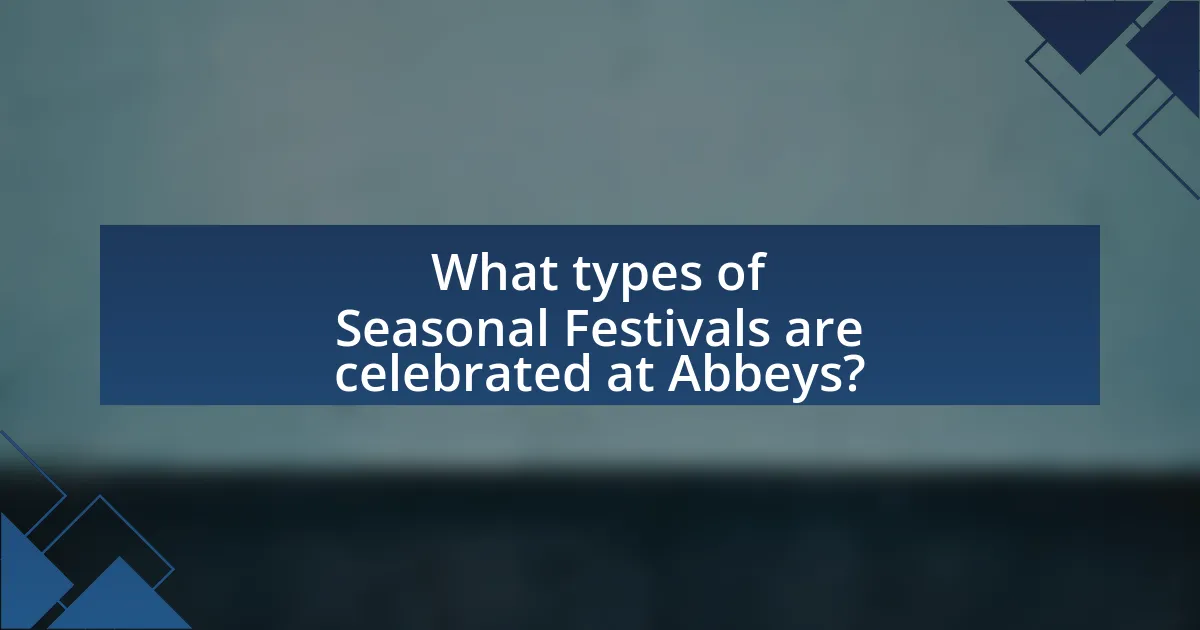
What types of Seasonal Festivals are celebrated at Abbeys?
Abbeys celebrate various seasonal festivals, including Harvest Festivals, Advent, and Easter. Harvest Festivals at abbeys typically involve giving thanks for the crops and often include communal feasting and blessings of the harvest. Advent marks the beginning of the Christian liturgical year, celebrated with special services and preparations for Christmas. Easter, commemorating the resurrection of Jesus, is celebrated with liturgical services, feasts, and various traditions that vary by region. These festivals reflect the agricultural calendar and religious observances, showcasing the historical significance of abbeys in community life.
What are the key characteristics of Spring Festivals at abbeys?
Spring Festivals at abbeys are characterized by communal celebrations, religious observances, and seasonal rituals. These festivals often include processions, feasting, and the decoration of the abbey with flowers and greenery, symbolizing renewal and rebirth. Historically, they served to mark important liturgical events such as Easter, emphasizing themes of resurrection and hope. Additionally, these festivals fostered community bonding and showcased local agricultural produce, reinforcing the connection between the abbey and the surrounding land.
How do abbeys celebrate the arrival of spring?
Abbeys celebrate the arrival of spring through various liturgical and communal activities that reflect the renewal of life. These celebrations often include special masses, prayers, and blessings that emphasize themes of rebirth and growth, aligning with the Christian calendar’s observance of Easter, which typically falls in spring. Historical records indicate that many abbeys also engage in agricultural practices, such as planting new crops and tending to gardens, which symbolize the season’s vitality and the monastic commitment to self-sufficiency. Additionally, abbeys may host community gatherings or festivals that feature music, feasting, and the decoration of the abbey with spring flowers, further enhancing the sense of joy and renewal associated with the season.
What rituals are commonly associated with Spring Festivals?
Spring Festivals commonly feature rituals such as planting ceremonies, egg decorating, and communal feasting. These rituals symbolize renewal and fertility, reflecting the season’s themes of growth and rebirth. For instance, egg decorating is rooted in ancient traditions that view eggs as symbols of new life, while planting ceremonies mark the beginning of the agricultural season, emphasizing the importance of crops in sustaining communities. Communal feasting often includes seasonal foods, celebrating the bounty of spring and fostering community bonds.
What unique traditions are observed during Summer Festivals at abbeys?
Unique traditions observed during Summer Festivals at abbeys include the blessing of crops, communal feasting, and the performance of traditional music and dance. These practices are rooted in the agricultural calendar, where abbeys historically served as centers of farming and community life. For instance, the blessing of crops symbolizes gratitude for the harvest and is often accompanied by prayers for a bountiful yield. Communal feasting fosters community spirit and celebrates the abundance of summer produce, while music and dance reflect the cultural heritage of the region, often featuring local instruments and folk traditions. These traditions not only enhance the spiritual atmosphere of the abbey but also strengthen community bonds, making the summer festival a significant event in the abbey’s annual calendar.
How do abbeys incorporate local agricultural practices into Summer Festivals?
Abbeys incorporate local agricultural practices into Summer Festivals by showcasing regional produce, hosting farm-to-table meals, and organizing agricultural competitions. These festivals often feature local farmers who provide fresh fruits, vegetables, and grains, reflecting the seasonal harvest. For example, many abbeys celebrate the Feast of the Assumption in August by highlighting the bounty of summer crops, which fosters community engagement and supports local agriculture. This practice not only promotes the abbey’s connection to the land but also reinforces the importance of sustainable farming within the community.
What are the main activities during Summer Festivals at abbeys?
The main activities during Summer Festivals at abbeys include outdoor liturgical services, music performances, art exhibitions, and community feasts. These festivals often feature traditional hymns and prayers, reflecting the abbey’s spiritual heritage. Additionally, local artisans may showcase their crafts, and visitors can participate in workshops that highlight historical practices. Such events foster community engagement and celebrate the abbey’s cultural significance, drawing on centuries of tradition in the context of seasonal celebrations.
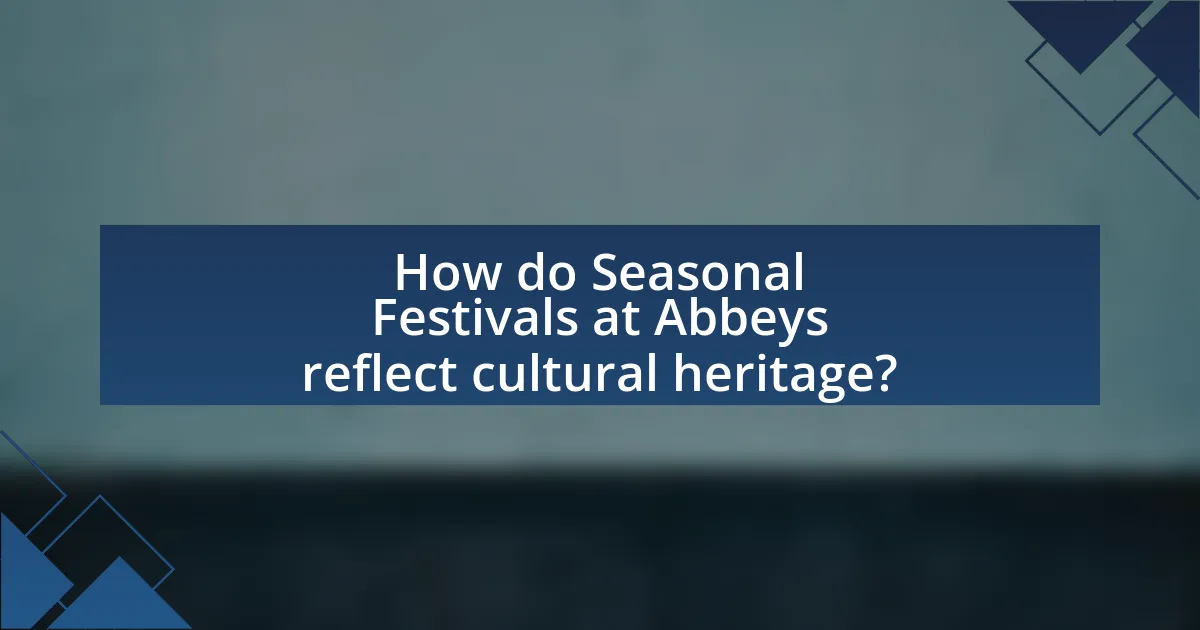
How do Seasonal Festivals at Abbeys reflect cultural heritage?
Seasonal festivals at abbeys reflect cultural heritage by preserving and showcasing traditional practices, rituals, and community values associated with the changing seasons. These festivals often incorporate historical customs, such as harvest celebrations, which highlight agricultural cycles and the agrarian roots of local communities. For instance, the Feast of St. Michael, celebrated in many abbeys, marks the end of the harvest season and emphasizes gratitude for the bounty, linking contemporary practices to centuries-old traditions. Additionally, these events foster community engagement and continuity, reinforcing social bonds and shared identity among participants, thus serving as a living testament to the cultural narratives that shape the region’s history.
What influences do local customs have on abbey festivals?
Local customs significantly influence abbey festivals by shaping the themes, rituals, and community participation involved in these celebrations. For instance, specific agricultural practices and seasonal changes in the region often dictate the timing and nature of the festivals, such as harvest celebrations that align with local crop cycles. Historical records indicate that abbey festivals often incorporate traditional music, dance, and food that reflect the cultural heritage of the surrounding community, enhancing the local identity and fostering communal bonds. Additionally, local religious practices and folklore can be integrated into the festivals, creating a unique blend of spiritual and cultural expressions that resonate with attendees.
How do abbeys adapt their festivals to reflect regional traditions?
Abbeys adapt their festivals to reflect regional traditions by incorporating local customs, foods, and practices into their celebrations. For instance, an abbey in a coastal region may include seafood dishes and maritime themes during its harvest festival, while an abbey in a mountainous area might emphasize local agricultural products and seasonal activities unique to that environment. This adaptation not only honors the cultural heritage of the surrounding community but also fosters a sense of belonging and participation among local residents, enhancing the overall experience of the festival. Historical records indicate that such adaptations have been a longstanding practice, allowing abbeys to remain relevant and connected to their regional identities.
What examples illustrate the blending of local culture and abbey celebrations?
Examples illustrating the blending of local culture and abbey celebrations include the Feast of St. Benedict, which incorporates local agricultural practices and seasonal harvests into its observance. This celebration often features local foods and customs, reflecting the community’s traditions alongside the abbey’s religious significance. Additionally, the Christmas markets held at various abbeys showcase local crafts and culinary specialties, merging the abbey’s spiritual atmosphere with regional cultural expressions. These events highlight how abbeys serve as focal points for both religious and local cultural festivities, fostering a sense of community and shared heritage.
How can visitors participate in Seasonal Festivals at Abbeys?
Visitors can participate in Seasonal Festivals at Abbeys by attending scheduled events, engaging in workshops, and enjoying guided tours that highlight seasonal traditions. These festivals often include activities such as local food tastings, craft demonstrations, and music performances that reflect the cultural heritage of the abbey. Historical records indicate that many abbeys have hosted seasonal celebrations for centuries, making these events a way for visitors to connect with the abbey’s history and community.
What are the best practices for engaging with abbey festivals as a visitor?
To engage effectively with abbey festivals as a visitor, plan your visit in advance by checking the festival schedule and understanding the specific events offered. Visitors should arrive early to secure parking and enjoy the atmosphere before the crowds gather. Participating in guided tours enhances the experience, as knowledgeable guides provide historical context and insights about the abbey and its traditions. Engaging with local vendors and artisans at the festival supports the community and allows visitors to experience regional crafts and foods. Additionally, respecting the abbey’s rules and maintaining a quiet demeanor in sacred areas is crucial to preserving the sanctity of the space. These practices ensure a respectful and enriching experience at abbey festivals, which often celebrate historical and seasonal themes tied to the abbey’s heritage.
How can one prepare for attending a Seasonal Festival at an abbey?
To prepare for attending a Seasonal Festival at an abbey, one should research the specific festival’s schedule, activities, and any required tickets or reservations. Understanding the festival’s theme, which often reflects the changing seasons, allows attendees to engage more fully with the experience. Additionally, checking the weather forecast and dressing appropriately for outdoor events is crucial, as many festivals take place in gardens or open spaces. Familiarizing oneself with the abbey’s history and significance can enhance appreciation for the event, as many abbeys have rich traditions tied to seasonal celebrations.


